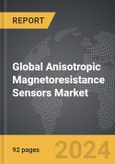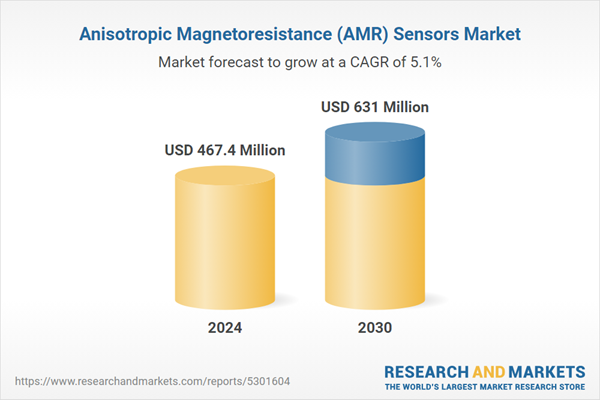Global Anisotropic Magnetoresistance (AMR) Sensors Market - Key Trends and Drivers Summarized
Why Are AMR Sensors Gaining Prominence Across High-Tech Industries?
Anisotropic Magnetoresistance (AMR) sensors are increasingly becoming a critical component in modern sensing applications, offering unique capabilities that are reshaping the landscape of various high-tech industries. AMR sensors are a type of magnetic sensor that detect changes in magnetic fields with high sensitivity and precision. Their core advantage lies in the anisotropic magnetoresistive effect, which allows them to convert small magnetic field changes into variations in electrical resistance. This enables AMR sensors to detect position, rotation, and linear displacement with exceptional accuracy. Compared to traditional magnetic sensors, AMR sensors are known for their low power consumption, wide bandwidth, and robustness against temperature variations, making them ideal for use in environments where reliability and precision are paramount. These sensors are widely used in automotive systems for position and angle sensing, industrial machinery for motor control, and consumer electronics for navigation and motion tracking. With the rise of automation and the growing need for contactless sensing solutions, AMR sensors are finding their way into new and emerging applications, solidifying their position as a key technology in the sensor market.What Trends Are Shaping the Evolution of the AMR Sensor Market?
The AMR sensor market is undergoing rapid evolution, driven by advancements in sensor technology, expanding application areas, and a surge in demand for precision sensing solutions. One of the most significant trends is the increasing integration of AMR sensors in automotive applications, particularly in electric vehicles (EVs) and advanced driver assistance systems (ADAS). As the automotive industry transitions to electrification and autonomous driving, the need for highly accurate current sensing, position monitoring, and speed detection is propelling the use of AMR sensors, which offer the precision and reliability required for these critical functions. Another emerging trend is the rising use of AMR sensors in industrial automation and robotics. With the global push towards smart factories and Industry 4.0, AMR sensors are being deployed for real-time motion control and positioning, enabling automated systems to operate with high precision and efficiency. Additionally, the development of miniaturized AMR sensors is expanding their application scope in consumer electronics, where they are being used in smartphones, wearables, and gaming devices for enhanced motion tracking and navigation capabilities. The incorporation of AMR sensors into smart home devices and security systems is also gaining momentum, as these sensors provide high accuracy in compact, low-power designs. Furthermore, advancements in multi-axis AMR sensing are opening up new possibilities for complex magnetic field mapping and three-dimensional sensing, making them a preferred choice in next-generation sensor systems. These trends are transforming the AMR sensor market, driving innovation and expanding their adoption across a wide array of industries.How Are Technological Innovations Driving the Development of AMR Sensors?
Technological innovations are at the forefront of the AMR sensor market, significantly enhancing the performance, sensitivity, and versatility of these sensors. One of the most impactful advancements is the development of multi-layer thin film technology, which improves the magnetoresistive effect, resulting in higher sensitivity and better signal-to-noise ratio. This enables AMR sensors to detect even the slightest changes in magnetic fields, making them ideal for high-precision applications such as automotive current sensing and industrial motor control. Another key innovation is the integration of complementary technologies like Giant Magnetoresistance (GMR) and Tunnel Magnetoresistance (TMR), which are being combined with AMR in hybrid sensor designs to offer enhanced performance characteristics, such as wider magnetic field ranges and lower hysteresis. Additionally, the emergence of digital AMR sensors with integrated signal processing capabilities is simplifying system design and reducing the need for external components, making these sensors easier to incorporate into a variety of applications. The use of AI and machine learning algorithms in AMR sensor data processing is another breakthrough, enabling more complex magnetic field analyses and predictive maintenance in industrial settings. These advancements are not only improving the functionality of AMR sensors but are also making them more accessible and cost-effective for a broader range of uses, from automotive safety systems to consumer electronics and beyond.What's Fueling the Growth of the AMR Sensor Market?
The growth in the AMR sensor market is driven by several factors, primarily influenced by technological advancements, expanding application areas, and evolving industry needs. One of the primary drivers is the increasing demand for precise and reliable sensing solutions in automotive applications. As the industry shifts towards electrification and autonomous driving, AMR sensors are being adopted for critical functions such as current sensing in battery management systems, position sensing in electric power steering, and angle detection in drivetrain components. The growing focus on safety and efficiency in electric and hybrid vehicles is further boosting the adoption of AMR sensors, which provide high accuracy and stability under varying environmental conditions. Another key driver is the rise of industrial automation and smart manufacturing, where AMR sensors are used for accurate motor control, robotics navigation, and machine health monitoring. With the push towards Industry 4.0, the need for sensors that can deliver real-time data and ensure precision in automated processes is fueling demand for advanced AMR solutions. The expanding use of AMR sensors in consumer electronics, driven by the miniaturization of sensor designs, is also contributing to market growth. These sensors are being integrated into wearables, smartphones, and gaming devices to enable motion tracking, navigation, and gesture recognition. Furthermore, the increasing need for compact, low-power sensors in IoT devices and smart home technologies is creating new opportunities for AMR sensor manufacturers. Advancements in sensor manufacturing techniques, such as wafer-level packaging and integrated signal processing, are reducing costs and enhancing the scalability of AMR sensors, making them more attractive for large-scale deployment. These factors, combined with a growing emphasis on energy efficiency and precision sensing, are propelling the AMR sensor market forward, establishing it as a cornerstone in the next generation of sensor technologies.Report Scope
The report analyzes the Anisotropic Magnetoresistance (AMR) Sensors market, presented in terms of market value (US$ Thousand). The analysis covers the key segments and geographic regions outlined below.- Segments: Application (Automotive, Consumer Electronics, Industrial, Other Applications).
- Geographic Regions/Countries:World; United States; Canada; Japan; China; Europe (France; Germany; Italy; United Kingdom; Spain; Russia; and Rest of Europe); Asia-Pacific (Australia; India; South Korea; and Rest of Asia-Pacific); Latin America (Argentina; Brazil; Mexico; and Rest of Latin America); Middle East (Iran; Israel; Saudi Arabia; United Arab Emirates; and Rest of Middle East); and Africa.
Key Insights:
- Market Growth: Understand the significant growth trajectory of the Automotive Application segment, which is expected to reach US$274.3 Million by 2030 with a CAGR of a 5.4%. The Consumer Electronics Application segment is also set to grow at 5.6% CAGR over the analysis period.
- Regional Analysis: Gain insights into the U.S. market, valued at $122.6 Million in 2024, and China, forecasted to grow at an impressive 7.8% CAGR to reach $140.8 Million by 2030. Discover growth trends in other key regions, including Japan, Canada, Germany, and the Asia-Pacific.
Why You Should Buy This Report:
- Detailed Market Analysis: Access a thorough analysis of the Global Anisotropic Magnetoresistance (AMR) Sensors Market, covering all major geographic regions and market segments.
- Competitive Insights: Get an overview of the competitive landscape, including the market presence of major players across different geographies.
- Future Trends and Drivers: Understand the key trends and drivers shaping the future of the Global Anisotropic Magnetoresistance (AMR) Sensors Market.
- Actionable Insights: Benefit from actionable insights that can help you identify new revenue opportunities and make strategic business decisions.
Key Questions Answered:
- How is the Global Anisotropic Magnetoresistance (AMR) Sensors Market expected to evolve by 2030?
- What are the main drivers and restraints affecting the market?
- Which market segments will grow the most over the forecast period?
- How will market shares for different regions and segments change by 2030?
- Who are the leading players in the market, and what are their prospects?
Report Features:
- Comprehensive Market Data: Independent analysis of annual sales and market forecasts in US$ Million from 2024 to 2030.
- In-Depth Regional Analysis: Detailed insights into key markets, including the U.S., China, Japan, Canada, Europe, Asia-Pacific, Latin America, Middle East, and Africa.
- Company Profiles: Coverage of players such as Analog Devices, Inc., Infineon Technologies AG, KOHDEN Co. Ltd., MEMSIC Semiconductor Co., Ltd., Multidimension Technology Co. Ltd. and more.
- Complimentary Updates: Receive free report updates for one year to keep you informed of the latest market developments.
Some of the 36 companies featured in this Anisotropic Magnetoresistance (AMR) Sensors market report include:
- Analog Devices, Inc.
- Infineon Technologies AG
- KOHDEN Co. Ltd.
- MEMSIC Semiconductor Co., Ltd.
- Multidimension Technology Co. Ltd.
- Murata Manufacturing Co., Ltd.
- NVE Corporation
- NXP SEMICONDUCTORS
- Sensitec GmbH
- TE Connectivity Corporation
This edition integrates the latest global trade and economic shifts into comprehensive market analysis. Key updates include:
- Tariff and Trade Impact: Insights into global tariff negotiations across 180+ countries, with analysis of supply chain turbulence, sourcing disruptions, and geographic realignment. Special focus on 2025 as a pivotal year for trade tensions, including updated perspectives on the Trump-era tariffs.
- Adjusted Forecasts and Analytics: Revised global and regional market forecasts through 2030, incorporating tariff effects, economic uncertainty, and structural changes in globalization. Includes historical analysis from 2015 to 2023.
- Strategic Market Dynamics: Evaluation of revised market prospects, regional outlooks, and key economic indicators such as population and urbanization trends.
- Innovation & Technology Trends: Latest developments in product and process innovation, emerging technologies, and key industry drivers shaping the competitive landscape.
- Competitive Intelligence: Updated global market share estimates for 2025, competitive positioning of major players (Strong/Active/Niche/Trivial), and refined focus on leading global brands and core players.
- Expert Insight & Commentary: Strategic analysis from economists, trade experts, and domain specialists to contextualize market shifts and identify emerging opportunities.
Table of Contents
Companies Mentioned (Partial List)
A selection of companies mentioned in this report includes, but is not limited to:
- Analog Devices, Inc.
- Infineon Technologies AG
- KOHDEN Co. Ltd.
- MEMSIC Semiconductor Co., Ltd.
- Multidimension Technology Co. Ltd.
- Murata Manufacturing Co., Ltd.
- NVE Corporation
- NXP SEMICONDUCTORS
- Sensitec GmbH
- TE Connectivity Corporation
Table Information
| Report Attribute | Details |
|---|---|
| No. of Pages | 180 |
| Published | December 2025 |
| Forecast Period | 2024 - 2030 |
| Estimated Market Value ( USD | $ 467.4 Million |
| Forecasted Market Value ( USD | $ 631 Million |
| Compound Annual Growth Rate | 5.1% |
| Regions Covered | Global |









